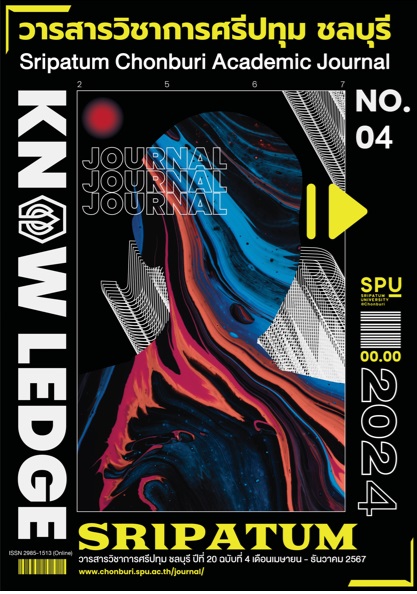THE RECOVERY OF RESTAURANTS AFTER THE SPREAD OF THE COVID-19 VIRUS IN THANYADURI DISTRICT, PATHUM THANI PROVINCE
Keywords:
Restaurant Recovery, Restaurant Business, Post-COVID-19Abstract
This research aimed to investigate the key factors that contributed to the recovery of restaurant entrepreneurs in Thanyaburi District, Pathum Thani Province, following the COVID-19 pandemic and to compare the characteristics of those restaurant entrepreneurs with the identified factors that influenced restaurant recovery. The study sample consisted of 100 restaurant owners operating dine-in establishments in Thanyaburi District, Pathum Thani Province. This sample size was determined using Krejcie and Morgan's sample size calculation formula, considering a total population of 135 restaurants. The researchers specifically targeted dine-in restaurants operating during evening hours, as these establishments were most severely impacted by the pandemic. Data were collected using a questionnaire administered to purposively selected restaurant owners and analyzed using various statistical methods, including frequency, percentage, mean, standard deviation, t test (Independent Samples), F test, and One-Way ANOVA Analysis.
It was found that 57 female entrepreneurs were women with an average age between 46 and 55 years old, 48 of them held bachelor's degrees, 39 restaurants’ average monthly revenue was higher than 45,001 baht, 37 restaurants had eight or more employees, and 39 restaurants had been in operation for 3 to 6 years. The following factors were identified as the most significant contributors to the recovery of restaurants in Thanyaburi District: 1) restaurant decoration: lighting design to create atmosphere (average importance rating of 3.70, considered very important), 2) location: proximity to suppliers (average importance rating of 3.69, considered very important), and 3) employee management: providing employees with the tools needed for success (average importance rating of 3.61, considered very important). In addition, the type of food served which included fast food, the price range of the food (0-100 baht), and promotional activities held every seven days were also factors contributing to the recovery of restaurants after the COVID-19 outbreak. When comparing the factors contributing to restaurant recovery, the following observations were made: The age of the entrepreneur had an impact on the recovery of the restaurant. Female entrepreneurs contributed more to restaurant recovery than male entrepreneurs. Entrepreneurs with higher education were perceived as more credible than those with lower education. However, the experience and duration of the restaurant owner's business also played a role in the restaurant's recovery. It was necessary for restaurants to reduce the number of employees and rely more on delivery services to achieve recovery.
References
กระทรวงสาธารณสุข. (2564). สถานการณ์โรคติดเชื้อไวรัสโคโรนา 2019 (COVID-19)มาตรการสาธารณสุขและปัญหาอุปสรรคการป้องกันควบคุมโรคในผู้เดินทาง (ออนไลน์). เข้าถึงได้จาก: https://ddc.moph.go.th/uploads/files/2017420210820025238.pdf [2564, 2 พฤศจิกายน].
คณะกรรมการโรคติดต่อ จังหวัดปทุมธานี. (2564, 10 กรกฎาคม). คำสั่งสำหรับมาตรการควบคุมพื้นที่เพื่อป้องกัน และควบคุมพื้นที่เพื่อการแพร่ระบาดของเชื้อไวรัสโควิด-19. หนังสือพิมพ์ไทยรัฐ. หน้า 15.
จารุมาศ แสงสว่าง และพิมพประภา เลื่อมใส. (2565). รายงานการวิจัย ความคิดเห็นของผู้ประกอบการร้านอาหารที่มีต่อสถานการณ์การแพร่ระบาดของโรคติดเชื้อไวรัสโคโรนา 2019 (COVID-19) ในเขตเทศบาลเมืองบุรีรัมย์. บุรีรัมย์: คณะวิทยาศาสตร์ มหาวิทยาลัยราชภัฏบุรีรัมย์.
จุฑาทิพย์ พรมวงศ์. (2562). พฤติกรรมการใช้บริการผับและสถานบันเทิงรอบสถานศึกษาของนักศึกษามหาวิทยาลัย ในเขตกรุงเทพมหานคร. วิทยานิพนธ์บริหารธุรกิจมหาบัณฑิต สาขาวิชาการตลาด คณะบริหารธุรกิจ มหาวิทยาลัยสุโขทัยธรรมาธิราช.
เรืองฉาย เรืองยังมี. (2565). รายงานการวิจัย กลยุทธ์การปรับตัวเพื่อความอยู่รอดของร้านอาหาร ขนาดเล็กช่วงการระบาดของโรคโควิด 19 ในเขตจังหวัดภูเก็ต. ภูเก็ต: คณะวิเทศศึกษา มหาวิทยาลัยสงขลานครินทร์ วิทยาเขตภูเก็ต.
ศิริรัตน์ โกศการิกา. (2564). รายงานการวิจัย กลยุทธ์การฟื้นฟูการให้บริการธุรกิจร้านอาหารที่ส่งผลต่อความพึงพอใจในบริการและความเชื่อมั่นในตราสินค้าในภาวะวิกฤติโควิด-19 ของประเทศไทย. กรุงเทพฯ: คณะบริหารธุรกิจ มหาวิทยาลัยเกษตรศาสตร์.
สุจิตรา บุณยรัตพันธุ์. (2534). ระเบียบวิธีวิจัยสำหรับรัฐประศาสนศาสตร์. กรุงเทพฯ: สถาบันบัณฑิตพัฒนบริหารศาสตร์.
สุภภัชชญา ทองคำผุย. (2565). การปรับตัวของธุรกิจร้านอาหารในสถานการณ์การแพร่ระบาดของโรคติดเชื้อไวรัสโคโรนา 2019 (COVID-19). วารสารโครงการทวิปริญญาโททางรัฐประศาสนศาสตร์และบริหารธุรกิจ, หน้า 1-13.
สำนักงานสถิติ จังหวัดปทุมธานี. (2564). รายงานสถิติจังหวัดปทุมธานี 2564. ปทุมธานี: สํานักงานสถิติ จังหวัดปทุมธานี.
เสาวณีย์ ตรีรัญเพชร, ศุภรัตน์ พิณสุวรรณ และวราภรณ์ ทนงศักดิ์. (2564). สภาพสถานการณ์และการปรับตัวของผู้ประกอบการร้านอาหารในพื้นที่ ตําบลเกาะยอ อําเภอเมือง จังหวัดสงขลา ภายหลังสถานการณ์โควดิ 19 (ออนไลน์). เข้าถึงได้จาก: http://www2.huso.tsu.ac.th/NCOM/GEOGIS2021/FULL_PAPER/PDF20211024221501_1.pdf [2564, 2 พฤศจิกายน].
Byrkit, D.R. (2020). Elements of Statistics (2nd ed.). New York: Litton Educational.
Downloads
Published
Issue
Section
License
Copyright (c) 2024 Sripatum University Chonburi Campus

This work is licensed under a Creative Commons Attribution-NonCommercial-NoDerivatives 4.0 International License.
บทความทุกบทความเป็นลิขสิทธิ์ของวารสารวิชาการศรีปทุม ชลบุรี



